http://www.rhci-online.net/radiogram/radiogram.htm

http://www.rhci-online.net/radiogram/radiogram.htm

RSID: <<2021-01-29T00:31Z MFSK-32 @ 9265000+1500>>
Welcome to program 189 of Shortwave Radiogram.
I'm Kim Andrew Elliott in Arlington, Virginia USA.
Here is the lineup for today's program, in modes as noted:
1:46 MFSK32: Program preview (now)
2:53 Laser link could test of Einstein's theory
6:51 Olivia 32-2000: Laser story continues
9:13 MFSK64: Telescope on the far side of the moon*
15:06 This week's images*
27:34 MFSK32: Closing announcements
* with image(s)
Please send reception reports to
radiogram@verizon.net
And visit http://swradiogram.net
Twitter:
@SWRadiogram
From Phys.org:
Record-breaking laser link could provide test of Einstein's
theory
by International Centre for Radio Astronomy Research
January 22, 2021
Scientists from the International Centre for Radio Astronomy
Research (ICRAR) and the University of Western Australia (UWA)
have set a world record for the most stable transmission of a
laser signal through the atmosphere.
In a study published today in the journal Nature Communications,
Australian researchers teamed up with researchers from the French
National Centre for Space Studies (CNES) and the French metrology
lab Systèmes de Référence Temps-Espace (SYRTE) at Paris
Observatory.
The team set the world record for the most stable laser
transmission by combining the Aussies' phase stabilization
technology with advanced self-guiding optical terminals.
Together, these technologies allowed laser signals to be sent
from one point to another without interference from the
atmosphere.
Lead author Benjamin Dix-Matthews, a Ph.D. student at ICRAR and
UWA, said the technique effectively eliminates atmospheric
turbulence. "We can correct for atmospheric turbulence in 3-D,
that is, left-right, up-down and, critically, along the line of
flight," he said. "It's as if the moving atmosphere has been
removed and doesn't exist. It allows us to send highly stable
laser signals through the atmosphere while retaining the quality
of the original signal."
The result is the world's most precise method for comparing the
flow of time between two separate locations using a laser system
transmitted through the atmosphere.
ICRAR-UWA senior researcher Dr. Sascha Schediwy said the research
has exciting applications. "If you have one of these optical
terminals on the ground and another on a satellite in space, then
you can start to explore fundamental physics," he said.
"Everything from testing Einstein's theory of general relativity
more precisely than ever before, to discovering if fundamental
physical constants change over time."
The technology's precise measurements also have practical uses in
earth science and geophysics. "For instance, this technology
could improve satellite-based studies of how the water table
changes over time, or to look for ore deposits underground," Dr.
Schediwy said.
There are further potential benefits for optical communications,
an emerging field that uses light to carry information. Optical
communications can securely transmit data between satellites and
Earth with much higher data rates than current radio
communications.
Story continues in Olivia 32-2000 ...
RSID: <<2021-01-29T00:36Z
OL 32-2K @
9265000+1500>>
This is Shortwave Radiogram in Olivia 32-2000 ...
"Our technology could help us increase the data rate from
satellites to ground by orders of magnitude," Dr. Schediwy said.
"The next generation of big data-gathering satellites would be
able to get critical information to the ground faster."
The phase stabilization technology behind the record-breaking
link was originally developed to synchronize incoming signals for
the Square Kilometer Array telescope. The multi-billion-dollar
telescope is set to be built in Western Australia and South
Africa from 2021.
https://bit.ly/3taUAVV
Changing to MFSK64 ...
RSID: <<2021-01-29T00:39Z MFSK-64 @ 9265000+1500>>
This is Shortwave Radiogram in MFSK64
Please send your reception report to
radiogram@verizon.net
From CBC Radio Quirks and Quarks:
Building Earth's largest telescope on the far side of the moon
NASA engineers are planning a kilometre-diameter radio telescope
to fit in a giant crater
January 22, 2021
NASA engineers are studying the feasibility of building a
massive, kilometre-wide radio telescope on the moon that would
dwarf anything we could build on Earth.
The telescope, which would be constructed by robots, would take
the form of a huge, wire-mesh antenna in a dish shape that would
hang suspended in a three-kilometre-wide crater on the far side
of the moon.
The Lunar Crater Radio Telescope would provide a unique
perspective on the early universe, though it likely won't be
built for decades, according to NASA robotics engineer Saptarshi
Bandyopadhyay, who is leading the project.
"We all want to know what happened. How did the universe evolve?
What happened after the Big Bang?" Bandyopadhyay told Quirks &
Quarks host Bob McDonald.
In the 14 billion years since that event, the light waves from
that era have been stretched out from tiny fractions of a
millimetre to more than 10 metres as the universe expanded.
They're now extremely long radio waves, and those can't be seen
on Earth "because the ionosphere absorbs it," said Bandyopadhyay.
"So we want to go somewhere away from [Earth] so that we can get
a picture of the Big Bang and evolution of the universe."
Telescope size presents challenges
The problem, however, is that in order to capture those
wavelengths, not only does this telescope need to be on the moon,
it needs to be very large, which makes it hard to build.
There are giant radio telescopes on Earth, which observe shorter
radio wavelengths that do penetrate the atmosphere. The
300-metre-wide Arecibo telescope in Puerto Rico — recently
demolished in a catastrophic accident — or the 500-metre-wide
FAST telescope in China represent significant engineering
challenges.
Standalone, self-supporting, dish-shaped radio telescopes can
only get to a certain size, based on the strength of the
materials they're made from and the need to resist wind loads. To
avoid these issues, the largest radio telescopes are built into
natural features in the terrain. Arecibo and FAST, for example,
were built in natural, dish-shaped sinkholes.
Building such a telescope on the moon is, in one sense, easier.
The lower gravity on the moon means a larger structure can be
built with lighter materials. No atmosphere means no windstorms
or other earthly environmental risks, though there are challenges
from the moon's harsh temperatures.
According to Bandyopadhyay, the moon also has no shortage of
appropriately shaped terrain structures in the form of ubiquitous
impact craters.
"These craters seem like natural places to put this dish-shaped
telescope because the crater also looks like a bowl."
To find a crater candidate, Bandyopadhyay and his team combed
over detailed pictures taken by NASA's Lunar Reconnaissance
Orbiter and discovered more than 80,000 suitable craters on the
far side of the moon.
Origami-inspired transport and construction
While the location would provide advantages, there are unique and
significant challenges to building on the moon, in particular the
harsh working conditions and the difficulty of transporting
materials.
The team studied a range of scenarios for how a telescope might
be constructed and transported to the moon. The one they have
arrived at is inspired by Japanese paper folding, said
Bandyopadhyay.
"Origami is the art of folding paper into smaller and more
interesting designs. But in space, origami is extensively used to
take these large structures, like a large dish of one kilometre,
and we can literally fold it multiple times and make it into a
pretty small structure."
The antenna would be built on Earth in the form of a large, but
extremely lightweight net-like structure made of conductive
aluminum wire. It would be carefully folded into a package that
would fit inside the nose cone of a large rocket, possibly the
Space Launch System that NASA is currently developing.
Once launched, the antenna would be carried to the moon and land
on the floor of the crater into which it would be installed. Then
it would need to be deployed.
"We will have these robots that will go down ... to the lander
and then pull lift wires that will connect to the lander sitting
at the crater floor," Bandyopadhyay said.
These lift wires would be anchored on the crater rim and as they
are winched up, the antenna would unfold and deploy. Ultimately
the net-like antenna would be suspended over the crater floor,
looking a little like a dish-shaped spider web.
The tension in the wires would be adjusted to result in the
appropriate dish shape to receive radio signals from space and
reflect them to a receiver.
All of this technology (the launch rocket possibly excepted) is
available today, said Bandyopadhyay.
The robots, for example, are currently being tested at NASA's Jet
Propulsion Laboratory.
"These robots are called DuAxel, and they are actively being
built at JPL for over a decade now. And these robots have the
speciality that they can go down almost steep terrain like just
cliff faces."
For now, this is an early stage engineering feasibility study,
rather than a fully developed mission proposal, but Bandyopadhyay
suggests it would certainly be expensive and would be a very
high-profile endeavour for NASA.
"Cost is a big uncertainty right now. Right now, all I can say is
we think this will be a flagship-class mission."
Given that, it's likely decades away, at least.
"Space is hard," said Bandyopadhyay. "I would be surprised if I
could see this launched and deployed before I retired, and I'm a
young scientist."
Written and produced by Jim Lebans
https://bit.ly/2MeabTE
The Pierazzo Crater on the far side of the Moon. From
https://bit.ly/2YozrJi ...
Sending Pic:301x201;

This is Shortwave Radiogram in MFSK64
Please send your reception report to radiogram@verizon.net
This week's images ...
An Arabian sand gazelle, known as Reem, on the outskirts of the
city of al-Ain at the far east of Abu Dhabi.
https://bit.ly/3ovsdOh ...
Sending Pic:199x155C;
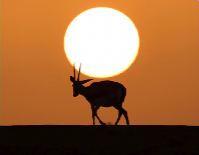
The arm of Russian artist Alla Urban is seen among her artwork
called The Question at the Tretyakov Picture Gallery in Moscow.
https://bit.ly/36ljAzQ ...
Sending Pic:203x149C;

A man walks through a blizzard in central Murmansk, part of an
RFE/RL pictorial on winter in Murmansk.
https://bit.ly/3t3VOBY
...
Sending Pic:190x181C;

A scene from the major snowstorm in the eastern United States,
January 27-28, 1922.
https://bit.ly/3cwuNBF ...
Sending Pic:301x196;
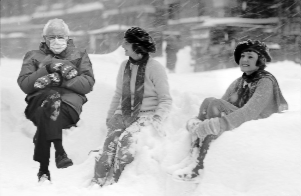
A night scene at the most photographed tree in Scotland at Loch
Lomond. https://bbc.in/2Ylr0yq ...
Sending Pic:159x204C;
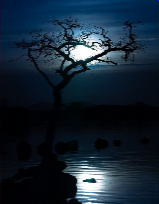
Frost patterns patterns on the sunroof of a car in Aberdeen,
Scotland. https://bbc.in/2Ylr0yq ...
Sending Pic:300x214;
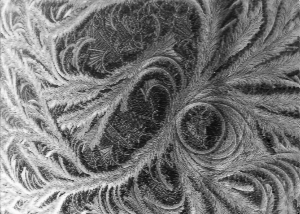
Our painting of the week is "Winter study with mountain" (1908)
by Wassily Kandinsky. https://bit.ly/2MBDbEE ...
Sending Pic:207x172C;

Shortwave Radiogram returns to MFSK32 ...
RSID: <<2021-01-22T00:58Z
MFSK-32 @
9265000+1500>>
This is Shortwave Radiogram in MFSK32
...
Shortwave Radiogram is transmitted
by:
WRMI, Radio Miami International, wrmi.net
and
WINB Shortwave, winb.com
Please send reception reports to
radiogram@verizon.net
And visit http://swradiogram.net
Twitter:
@SWRadiogram or twitter.com/swradiogram
I'm Kim Elliott. Please join us for the next Shortwave
Radiogram.
|
SWRG189 closing song: Jonas Gwangwa - Flowers Of The Nation - Flowers Of The Nation • 1990
|

http://www.rhci-online.net/radiogram/radiogram.htm
|
QTH: |
D-06193 Petersberg (Germany/Germania) |
|
|
Ant.: |
Dipol for 40m-Band & Boomerang Antenna 11m-Band |
|
|
RX for RF: |
FRG-100B + IF-mixer & ICOM IC-R75 + IF-mixer |
|
|
Software IF: |
con STUDIO1 - Software italiano per SDR [S-AM-USB/LSB] + beta 11 Version 2.80 (August 21, 2018) - for scheduled IF-recording |
|
|
Software AF: |
Fldigi-4.0.18 + flmsg-4.0.7 images-fldigifiles on homedrive.lnk |
|
|
OS: |
German XP-SP3 with support for asian languages |
German W7 32bit + 64bit |
|
PC: |
MEDION Titanium 8008 (since 2003) [ P4 - 2,6 GHz] |
MSI-CR70-2MP345W7 (since2014) [i5 -P3560 ( 2 x 2,6GHz) ] |
http://wiki.radioreference.com/index.php/Decoding_the_SW_Radiogram_Broadcasts
https://www.qsl.net/ve7vv/Files/Digital%20Modes.pdf
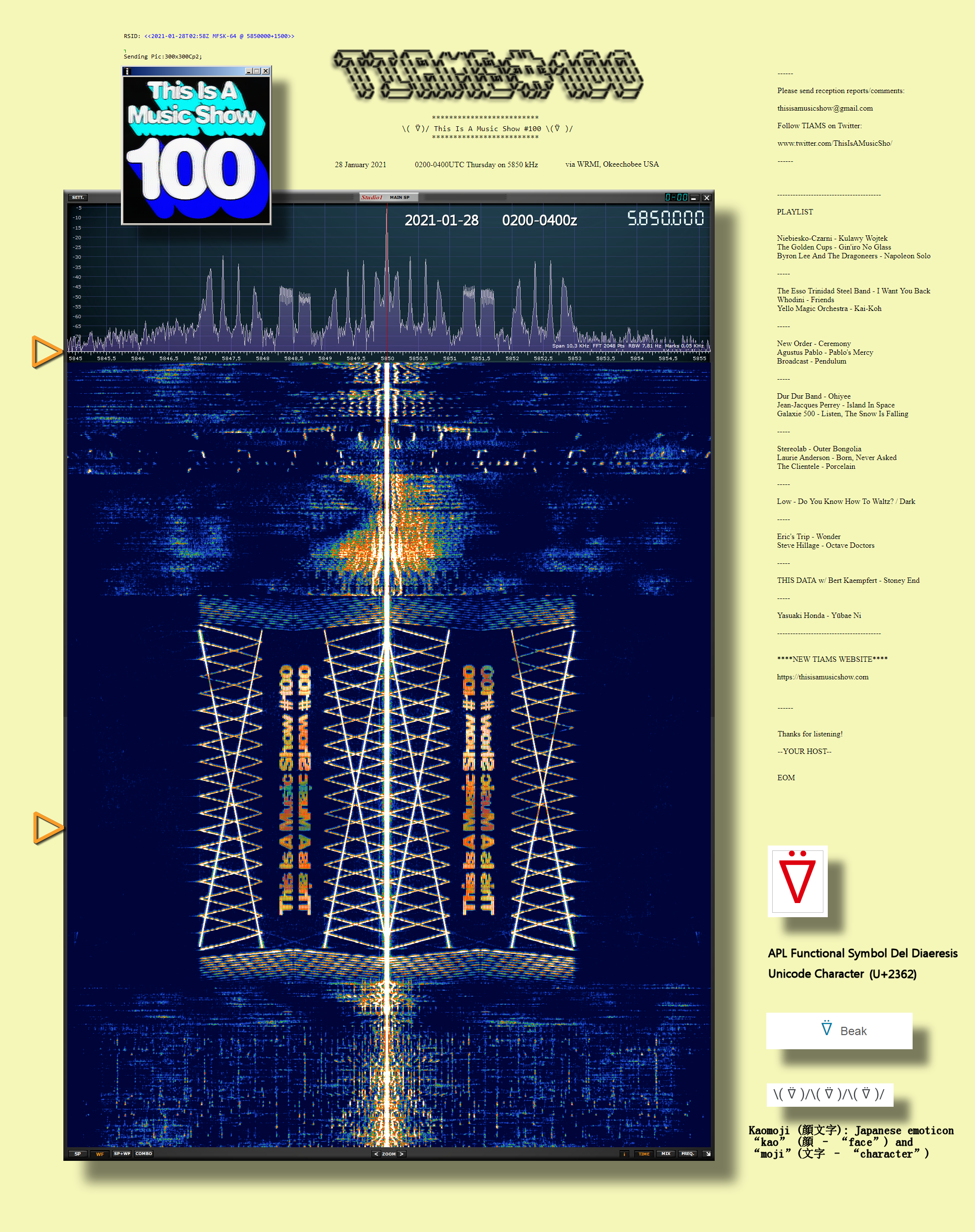
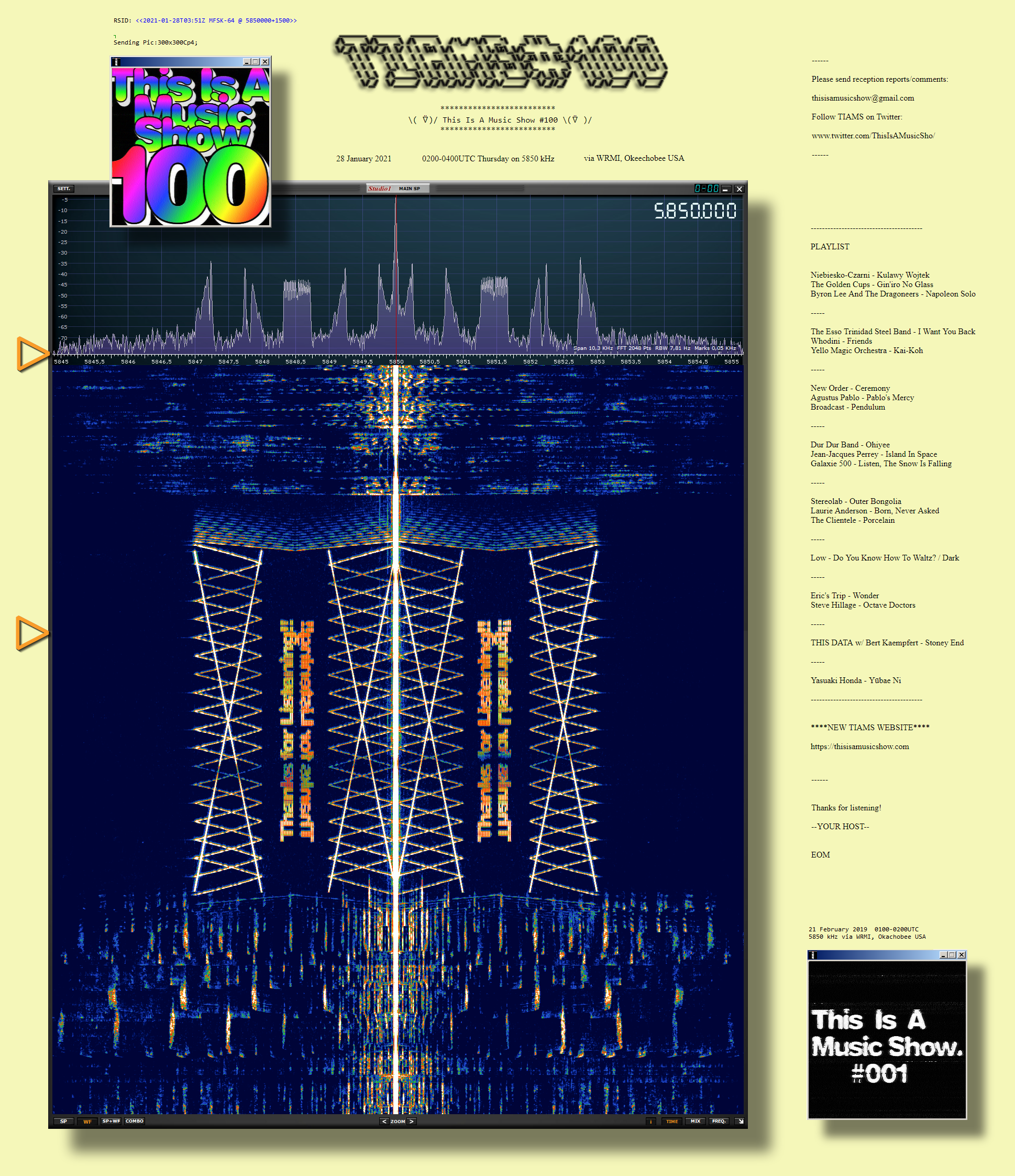
RSID: <<2021-01-28T02:58Z MFSK-64 @ 5850000+1500>>
Sending Pic:300x300Cp2;

RSID: <<2021-01-28T03:49Z MFSK-64 @ 5850000+1500>>

*************************
\( ⍢)/ This Is A Music Show #100 \(⍢ )/
*************************
28 January 2021
0200-0300UTC Thursday on 5850 kHz
( 0200-0400z !!)
via WRMI, Okeechobee USA
***ALSO***
TIAnExpressMS w/ Radio Northern Europe International
via Channel 292 in Germany, on 6070 kHz.
Broadcast various dates/times. Check the schedule here:
https://www.channel292.de/schedule-6070-khz/
https://rnei.org/
----------------------------------------
PLAYLIST
****NEW TIAMS WEBSITE****
https://thisisamusicshow.com
------
Please send reception reports/comments:
thisisamusicshow@gmail.com
Follow TIAMS on Twitter:
www.twitter.com/ThisIsAMusicSho/
------
Thanks for listening!
--YOUR HOST--
EOM
RSID: <<2021-01-28T03:51Z MFSK-64 @ 5850000+1500>>
Sending Pic:300x300Cp4;

RSID: <<2021-01-31T01:30Z MFSK-64 @ 5960000+1500>>
Phil Collins was born January 30, 1951.
Sending Pic:250x190;

genesis-music.com
Please report your decode to
themightykbc@gmail.com